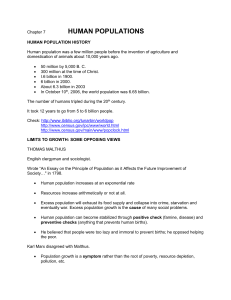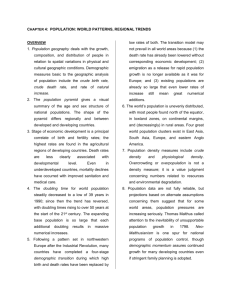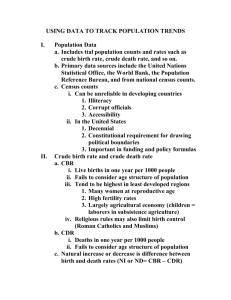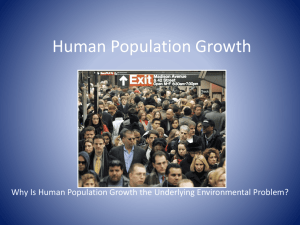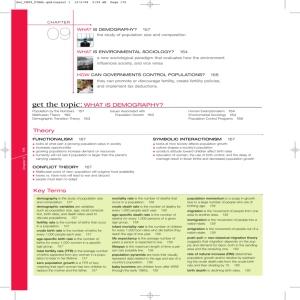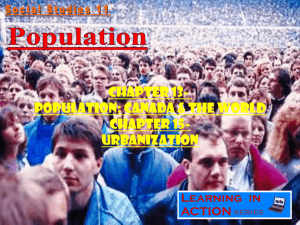Advanced Sociology Lecture 8 POPULATION STUDY AND ITS
advertisement
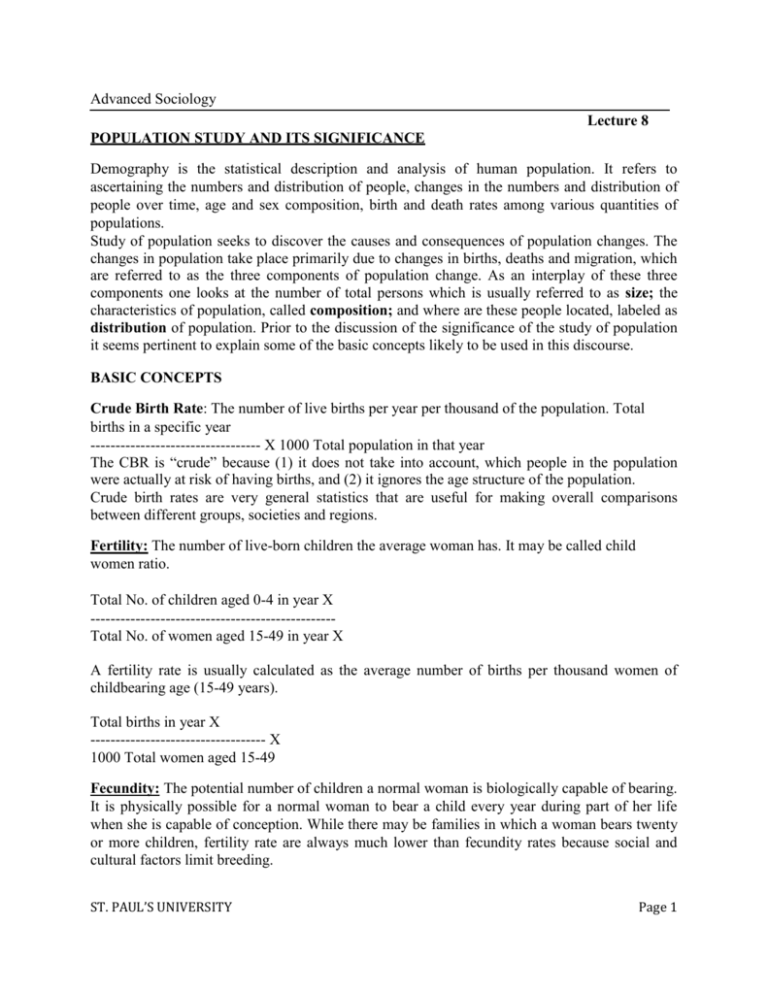
Advanced Sociology Lecture 8 POPULATION STUDY AND ITS SIGNIFICANCE Demography is the statistical description and analysis of human population. It refers to ascertaining the numbers and distribution of people, changes in the numbers and distribution of people over time, age and sex composition, birth and death rates among various quantities of populations. Study of population seeks to discover the causes and consequences of population changes. The changes in population take place primarily due to changes in births, deaths and migration, which are referred to as the three components of population change. As an interplay of these three components one looks at the number of total persons which is usually referred to as size; the characteristics of population, called composition; and where are these people located, labeled as distribution of population. Prior to the discussion of the significance of the study of population it seems pertinent to explain some of the basic concepts likely to be used in this discourse. BASIC CONCEPTS Crude Birth Rate: The number of live births per year per thousand of the population. Total births in a specific year ---------------------------------- X 1000 Total population in that year The CBR is “crude” because (1) it does not take into account, which people in the population were actually at risk of having births, and (2) it ignores the age structure of the population. Crude birth rates are very general statistics that are useful for making overall comparisons between different groups, societies and regions. Fertility: The number of live-born children the average woman has. It may be called child women ratio. Total No. of children aged 0-4 in year X ------------------------------------------------Total No. of women aged 15-49 in year X A fertility rate is usually calculated as the average number of births per thousand women of childbearing age (15-49 years). Total births in year X ----------------------------------- X 1000 Total women aged 15-49 Fecundity: The potential number of children a normal woman is biologically capable of bearing. It is physically possible for a normal woman to bear a child every year during part of her life when she is capable of conception. While there may be families in which a woman bears twenty or more children, fertility rate are always much lower than fecundity rates because social and cultural factors limit breeding. ST. PAUL’S UNIVERSITY Page 1 Death Rate: The number of deaths per thousand of the population per year. Total death in a specific year ----------------------------------- X 1000 Total population in that year Crude death rates are also called as mortality rates. Mortality: The number of deaths in a population. Infant Mortality Rate: The number of babies per thousand live births in any year who die before reaching the age of one year. Life Expectancy: The number of years an average person can expect to live. Life expectancy has increased in most societies in the world in the past century. Life Span: The maximum number of years that an individual could live. Migration: The Permanent movement of persons over a significant distance. International migration: Migrant crosses the boundary between one country and another. Emigrant: When persons leave their country. Immigrant: When persons arrive in another country. Internal migration: Migration within a country. Population Census: The simultaneous recording of demographic data by government, at a particular time, pertaining to all persons who live in a particular territory. It usually takes place after every 10 years. Vital Statistics: Registration of a person’s birth, changes in civil status throughout his/her lifetime, and his/her death. 1. 2. 3. SIGNIFICANCE OF POPULATIONS STUDY There are three main questions to look into the significance of population study: How many people? It refers to the size of the population in a territory. While looking at the size, one also looks at the changes that are taking place in the size. How are these changes being effected by the trends in birth rate, death rate, and in migration? What kind of people? It refers to the composition of the population. The composition includes the characteristics of the population with respect to the age structure, sex differences, literacy rate and levels of literacy, religious distribution, languages people speak, occupational structure, housing structure, etc. In addition to the absolute figures showing the characteristics one also looks at the changes that might be taking place in the composition of the population as well as its future implications. How are people distributed in the area? Distribution of population refers to the dispersion of people in a territory like the rural-urban distribution, size of cities, densities of population. ST. PAUL’S UNIVERSITY Page 2 Analysis of the distribution takes into account the prospective changes as well as its future effects. People belonging to different walks of life are interested in the existing as well as the foreseeable trends in the size, composition and distribution of population. For example a planner is looking at the size of the population because he has to tie it with other social and economic resources of the country. He has to look into the correlations between the size of population and the economic development of the country. How are the changes in population size influencing the economic development and vice a versa? The composition of the population may be reflective of quality of the human resource, which can be utilized for the development of the economy. The changes in the composition may also suggest the kind of investments needed in the various components of the population. The distribution of population is of specific interest to the planner when he has to look into the varying needs of people at different places. From the political perspective one has to look into the size of population while determining the boundaries of constituent areas as well as the number of members of the National Assembly, the Senate, and Provincial Assemblies. The information about the composition as well as the distribution of population helps in the determining the number of voters, the type of voters, and the location of voters. A businessman shall be interested in the population because he uses the manpower in the production of goods and services and ultimately he shall be looking for the consumers of his goods and services. At various stage of his business operations he shall be interested in all the three components of population i.e., size, composition, and distribution. He produces goods and services keeping in view the characteristics of the ultimate consumers. The study of population is of utmost significance to an educationist because he has to look into the educational needs of the population and arrange the facilities accordingly. What is the size of population, of which how many are of school going age, what is the their gender, what is the occupational background of their parents, where are they located - in rural/urban areas, are some of the pertinent questions about which he should have enough information prior to chalking out an action program. The study of population helps in providing the relevant information. These examples suggest that in whatever field we work, the demographic information is of utmost value for planning, implementation, and success of any plan. The causes and consequences of changes in the size, composition, and distribution of population have a bearing on the socio economic development of the country. THEORY OF POPULATION GROWTH In pre-modern societies, birth rates were very high by the standards of industrialized world today. Nonetheless, population growth quite was low until the 18th century because there was a rough overall balance between births and deaths. The general trend of the numbers was upwards, and there were sometimes periods of more marked population increase, but these were followed by increase in death rates. During the period of the rise industrialism, many looked forward to a new age in which scarcity would be a phenomenon of the past. The development of modern industry, it was widely supposed, would create a new era of abundance in which standards of living would rise. These ideas were criticized by Thomas Robert Malthus (1766-1834), a ST. PAUL’S UNIVERSITY Page 3 clergyman and an economist. Malthusian Theory of Population In 1798 Malthus published an Essay on the Principle of Population. By analyzing the then prevailing situation in different countries Malthus initiated a debate about the connection between population and food resources that continues to this day. His premise was that: (1) food was necessary for the continuation of life, and (2) procreation was also necessary for the continuation of life. Necessity of food for human survival is to continue, similarly the passions between the sexes are to continue, and both are natural necessities of life. But the two necessary factors of human life grow at different rate. Whereas population size increases geometrically (2, 4, 8, 16, 32, 64), the food supply increases arithmetically (1, 2, 3, 4, 5, 6,). Population size, therefore, always pushes against the limits of food supply needed to support the population. There is a limit to increase the food supply by bringing more land under cultivation but there is limit to that. With the existing rate of growth, the population was expected to double every 25 years. For such a high growth rate of population, human beings should adopt such measures to check the growth of population. In his opinion the population checks were: a. b. Preventive checks, and Positive checks. Among the preventive checks, Malthus recommended (1) to follow celibacy (2) to marry late, (3) abstinence from entering into sexual unions resulting in procreation. If human beings don’t adopt the “preventive checks”, “positive checks” come into operation in the form of famine, epidemics, war, and other natural calamities, and a lot of population is wiped out. For the remaining population food supply may be sufficient, though it may be a temporary relief. 1. 2. 3. There has been lot of criticism of Malthusian theory of population by arguing that: Malthus did not visualize the power of science and technology with the help of which the food supply could be revolutionized. Even one country like Canada could produce so much of wheat that could be sufficient for the whole of the world. But will Canada supply wheat free? Not at all. Even if it is free some countries may not even have the ability to bear the transportation costs. Malthus did not advocate the use of contraceptives as a means of preventive measure, though these were available during his times. Being a clergyman perhaps he did not consider the advocacy of the use of contraceptives as appropriate. Malthus presented a too pessimistic picture of the growth of population. Population of many technologically advanced countries did not follow his predictions. Nevertheless, the essay on population growth by Malthus generated lot of discussion on the topic, and Malthus may rightly be considered as the father of population studies. The more guarded outlook is that we no longer could use technology as an excuse to ignore Malthus. Theory of Demographic Transition Demographic transition theory links birth rates and death rates to a society’s level of industrialization – the process by which a society’s economy shifts from a predominantly agricultural and handicraft base to a predominantly industrial and large scale manufacturing base. There are four stages in the demographic transition as seen in the figure. ST. PAUL’S UNIVERSITY Page 4 During the pre-industrial stage, high birth rates are balanced by high death rates, and population size remains fairly stable. Today the least industrialized nations of the world are in this demographic stage. During stage 2, the stage of increasing industrialization, the death rate falls primarily because of the improved sanitation, hygiene, and medical conditions. The birth rate, however, remains high because of the continued influence of traditional values favoring large families. Having several children ensures survival of at least some of them when infant mortality is high. During this stage the imbalance between the falling death rate and the high birth rate results in high population growth. Pakistan like many other developing nations is in this stage of transition. At the third stage the traditional values give way to modern values favoring contraception and family planning. Birth rates decline as a result of later ages at marriage, urbanization, industrialization, rising aspirations, and other factors. The mortality rates eventually stabilize at low level and birth rates follow. The shift from high to low mortality and fertility is known as the “demographic transition”. This shift occurred throughout Europe, North America, and a number of other areas in the 19th and early 20th centuries, and started in many developing countries in the middle of 20th century. ST. PAUL’S UNIVERSITY Page 5 Although the pace and paths of decline varied tremendously among countries, the demographic transition emerged as the dominant model of demographic change. At the fourth stage the birth rates fall to about the same level as mortality rates. With births and deaths at similar low levels, the equilibrium of slow population growth is regained. The pace of change in a country varies depending on its culture, level of economic development, and other factors. As countries pass through the various stages of the transition, population growth from natural increase (birth rate - death rate) accelerates or decelerates depending upon the gap between birth rate and the death rate. Many developing countries are in an intermediate stage, in which mortality and fertility are falling at varying rates but are still high relative to the levels of Europe and other more developed areas. Many low-fertility countries have entered what some describe as a “second demographic transition” in which fertility falls below the two-child replacement level as forces of contemporary life interfere with childbearing. This transition has been linked with greater educational and job opportunities for women, the availability of effective contraception, a shift away from formal marriage, the acceptance of childbearing outside marriage, and the rise of individualism and materialism. Experts disagree about whether all countries will follow the transition experienced in Europe and about whether there are additional stages of transition that we have not identified – long-term population decline, for example. But the demographic transition theory provides a useful framework for assessing demographic trends and projecting future population size. ST. PAUL’S UNIVERSITY Page 6

